Posted by Patrick Weiler on 04-29-2003 10:49 PM:
A Tough One ?
Here is a chanteh that may or may NOT be Luri:
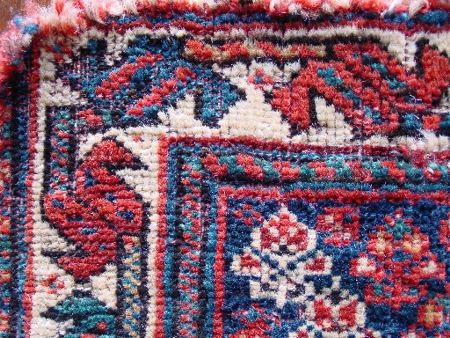
It has the same border as
many Luri bags, the one Opie says may well be originally Luri, and a miniature
rosette with a "dice" interior.
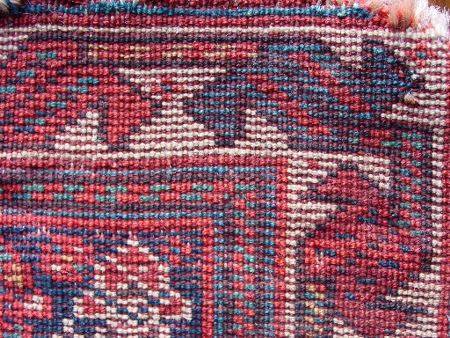
It has an undepressed warp,
red wefts and white warps, similar to the southern Lur weavings.
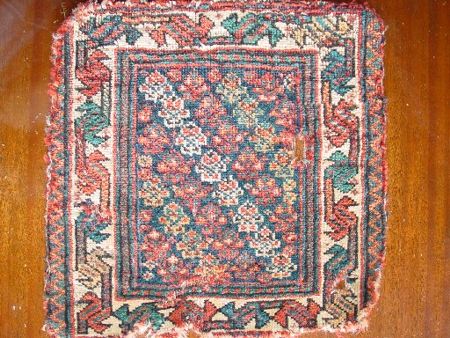
The outer border of a
zig-zag is the same as one of the rugs in the salon, which you can see part of
here:
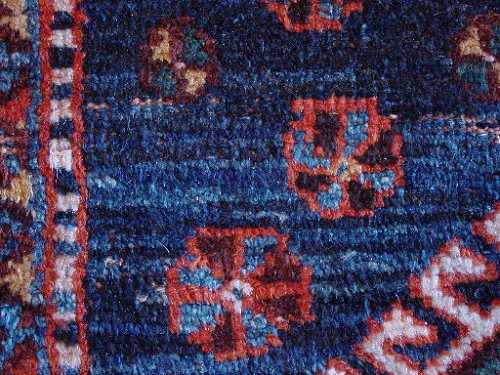
This
zig-zag border is also on the large khorjin in the salon, as is a "dice"
border.
And the major design, of a shrub, may be a miniature version of
the shrub rug on page three of the salon:
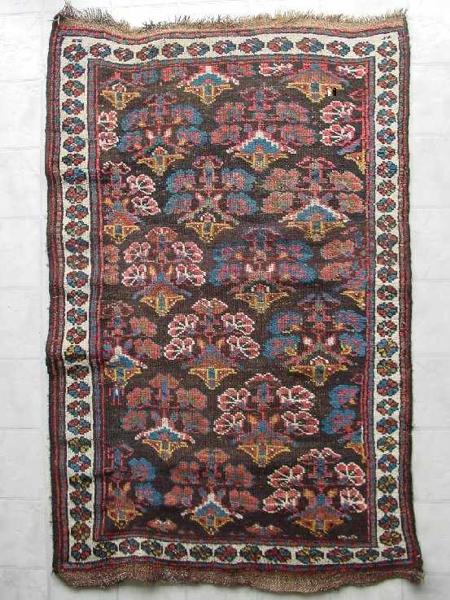
What do you
think?
Patrick Weiler
Posted by Vincent Keers on 04-30-2003 08:09 PM:
Dear Patrick,
Here's the Beloudj I once had
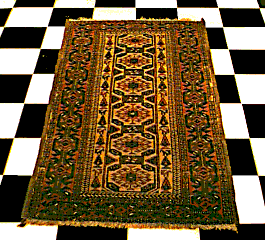
And here's the border from
the chanteh

The
two borders are the same.
Up to this moment I still believe this type of
design setting isn't very common.
In the chanteh design, the colour switch
makes the
S dominant. But in the Beloudj, this isn't the
case. The
vertical lines that connect the S shapes
are essential. Without the line...no
cross design.
It seems these two pieces are connected in this
way.
But a Beloudj isn't a Luri,
and the Chanteh isn't a Beloudj
Best regards,
Vincent
Posted by Patrick Weiler on 04-30-2003 08:54 PM:
Vincent,
It is interesting that you should show this rug. The border
design on the beloudj is similar to what is called the Badam, or almond design
in Afghan rugs. It does look similar to this Luri "S" or dragon or bird-head
border.
It is also a lot like another version in Anatolian rugs. I will show
an example tomorrow.
As for Beloudj rugs, they are one of the few sources of
tribal prayer rugs from Iran. The article on the New England Rug Society web
site about prayer rugs:
http://www.ne-rugsociety.org/gallery/prayer-rugs-fall-2002/ners-prayer-rug-intro.htm
details
reasons for the relatively few prayer rugs from Iran. These include the use of
the prayer stone, or mohr, in Iran. This was placed on a qalamkar, or printed
prayer cloth, and the forehead was placed on the mohr. The qalamkar was then
used as a bokcha, or covering, to carry the prayer stone. This meant that prayer
rugs were not as common for use in prayer as they were in Anatolia. Most of the
Iranian and Caucasian prayer rugs were woven for commercial sale, including the
fine Kerman, Isphahan, Qum and other "city" prayer rugs.
Why the Beloudj
wove prayer rugs is not mentioned. I have only seen one rug attributed to Luri
weavers that is in a prayer format. The suggestion that most Luri weaving was
not commercial is the most likely reason for the dearth of Luri prayer rugs,
rather than the possibility that their pre-Islamic religious traditions
prohibited them from weaving them.
Patrick Weiler
Posted by Tracy Davis on 05-01-2003 01:15 PM:
Luri or not?
Patrick, what would you think of this rug? It's approx. 5x7, with red and
blue barber-pole selvages. It has a darker, more "Luri" palette, and I have a
gut-level reaction that wants to call it Lur. However, the wool is quite soft
and the pile is long, which isn't typical, and it has those little turkic motifs
and soccer-ball-style rosettes.
This photo is the top half of the
rug:
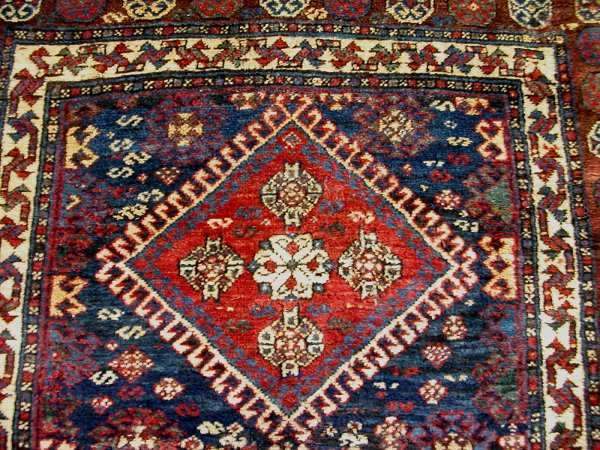
Posted by Patrick Weiler on 05-02-2003 12:11 AM:
The top half is really nice!
Tracy,
Since we all know that we can't trust you anymore,  ........
........
This rug looks for all the
world like a "typical" Khamseh khorjin, but with what appears to be an extra
border on a brown ground.
One feature that seems to show up on many Khamseh
khorjin is the half-diamond along the edge of the field.
Many of the other
motifs are shared in the SW Persian milieu.
And, frankly, it is just not
crude enough!
Perhaps when you tell us The Rest of The Story (a photo of the
whole rug? structural features?)
I particularly like the striations in the
blue field.
By the way, the chanteh face I showed above has a knot count
of 9x13, nearly 120kpsi, probably too high for a Luri weaving.
Patrick
Weiler
Posted by Chuck Wagner on 05-02-2003 01:36 AM:
Border Patrol
Hi Pat,
From the For-What-It's-Worth department, I'll offer the
following
observation: That zig-zag border is commonly seen on
Qashqai
work as well as Luri, and apparently made it's way up
the
mountains into the southern Caucasus, as seen in Wertime's
book on
Caucasian Prayer Rugs. Congrats on a nicely prepared
salon.!
Regards,
Chuck
__________________
Chuck
Wagner
Posted by Patrick Weiler on 05-02-2003 09:30 AM:
Border
Vincent,
Here is a photo of a similar border from an Anatolian prayer
rug:

It may
have originated as a floral meander and became the various geometric versions
seen in 19th century tribal weavings. Notice also a couple of different zig-zag
borders, one a thin, single line and the other a more blocky
version.
And, for Chuck, a photo of the zig-zag border from the large
khorjin, along with one of the "dice".
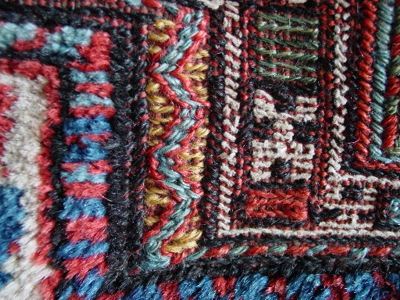
Patrick Weiler
Posted by Chuck Wagner on 05-02-2003 11:46 AM:
Communications Breakdown
Hi Pat,
Thanx, but I meant the the larger border that you show
in
the first image of your reply, the blocky meander with
the arrows at each
segment end. Hindsight shows that I
misread your original post. I hate it
when it does that... 
Nice closeup of the khorjin !
Regards
Chuck
__________________
Chuck
Wagner
Posted by Patrick Weiler on 05-04-2003 01:30 AM:
Zeroing In
Chuck,
Are you referring to the border design that is similar to the
one Tracy shows in her rug? The one similar to the middle border in the
Anatolian Camardi rug?
The one Vincent so adroitly mirrored?
It could be
said to be derived from dragons, bird's heads, evil-eye diverting devices or, my
personal favorite, a geometric floral meander.
This border seems to show up
in rugs from a lot of different places.
Are you aware of this border in
any flatweaves? Many minor motifs have been modified from flatweave traditions.
If the feeling is that the Lurs pile weaving was a later phenomenon, then
perhaps their most identifiable pile motifs would have followed from their
flatweave tradition. The "plain" zig-zag, as seen in some Luri pile rugs,
certainly can be easily woven in a sumak, as the close-up of the khorjin readily
shows.
If so, would it not be likely that this common Luri design, too,
started as a flatweave design?
Which plate(s) in the Wertime book are
you referring to?
Patrick Weiler
Posted by Chuck Wagner on 05-04-2003 01:30 PM:
Pat,
Here are a couple partials from the book I was referring to,
"Caucasian Carpets and Covers: the weaving culture" by
Richard E. Wright
& John T. Wertime (Hali Pub. Ltd., 1995)
The first is illus. 40, from
a design drawing album dated 1913:

The second is plate V, a piled
saddle bag the authors attribute to the Kuba district:
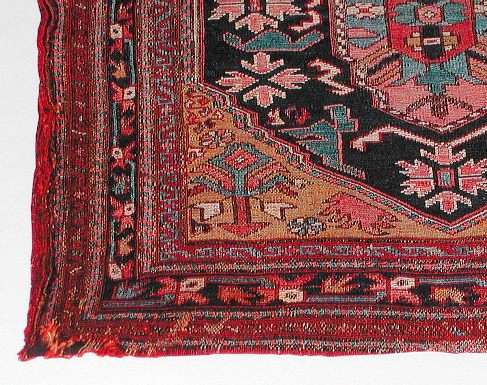
I haven't personally seen any
flatweaves with this border but I'd
be surprised if they're not around
somewhere. As I mentioned earlier,
it does seem that this border design that
is in use up the Zagros all the
way into the Caucasus. I have a recent
Qashqai rug with this border,
so it's clearly still in use today.
The
resemblence of the terminating elements to the Afghan Badam
design is quite
clear in the first illustration, but not nearly so in the
second. I suspect
it's more likely related to "boteh miniaturization" than
Afghan
transmogrification.
Regards,
Chuck
__________________
Chuck
Wagner
Posted by Vincent Keers on 05-04-2003 07:28 PM:
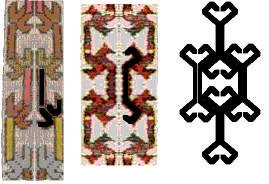
Hi Patrick and
Chuck,
The 2 designs do look the same at first sight.
And maybe they
are related.
But it looks as if one is floral and the other isn't.
If the
Beloudj was made in Persia, this could
explain why the border design is of
the same
construction as the S.W. Persian design.
I never thought the
Beloudj was a prayer rug.
More something like a graveyard rug because of
all
the cypresses and the Falcon on top. Something to
do with the circle
of live.
Thanks,
VincenttnecniV
Posted by Patrick Weiler on 05-04-2003 11:55 PM:
Chuck,
Your first photo certainly shows, very clearly, the same border
as seen in the Anatolian rug. I have a Shirvan Baku with a similar border that
has even shorter "stems" between the flowers.
In the Luri rugs, though, (and
in Tracy's mystery rug) the "heads" of the birds go opposite ways, one is up and
the other is down. In the Caucasian and Anatolian rugs, the "petals" open to the
left and right. Vincent is right, these two border types may originate from
different sources.
They may be two completely different border types that
just look similar, the Luri border being a "bird on a pole" and the
Anatolian/Caucasian border being a geometricized floral meander.
It is well
known that North and East Anatolia share a fluid border with Armenia. It is not
unlikely that the floral meander travelled between the two cultures. Bennett
shows a Lori Pambak, page 25, with a possibly related floral border. Do the Lori
Pambak Caucasian rugs fit somewhere into this puzzle? If the border design did
travel between them, which way did it flow? If it is, in fact, a tulip, one
might think it travelled from Turkey, the land of the tulip, to the
Caucasus.
Patrick Weiler
Posted by Steve Price on 05-05-2003 05:42 AM:
Hi Patrick,
Perhaps you were saying this, but I'll point it out
anyway. I believe that the "Lori" part of "Lori Pombak" refers to the same
friendly folks we have been referring to as Luri.
Regards,
Steve
Price
Posted by Patrick Weiler on 05-05-2003 09:54 AM:
Luri, Lori
Steve,
You are correct. I was throwing out the Lori Pambak link
because the border is seen in the Caucasus and Luristan. I do not recall any
references showing how Lurs got to the Caucasus, when they went there or if they
consider themselves Luri or not. Lurs were moved about by various empires, but
when this happened I do not know. Perhaps you could enlighten us? 
Patrick Weiler
Posted by M. Wendorf on 05-05-2003 11:15 AM:
Kurds also used border
People:
Lest we forget, this border was also used by Kurds weaving
rugs with Persianate designs such as the herati. Witness this well colored
rug:
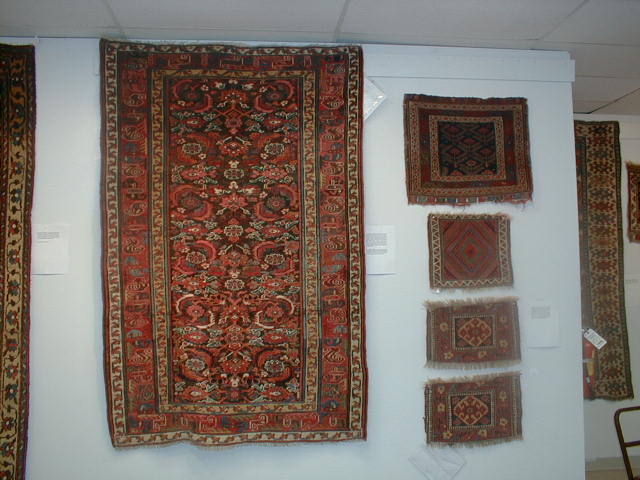
This
carpet was part of the Traditional Kurdish Rugs exhibition mounted by the NEARC
in 1999. Another example is in Discoveries From Kurdish Looms.
Thanks,
Michael
Posted by Patrick Weiler on 05-05-2003 04:00 PM:
Bordering on Insanity
Dear Border Enthusiasts,
As Michael has pointed out, this border is
used by many weavers.
Here are a couple more examples:
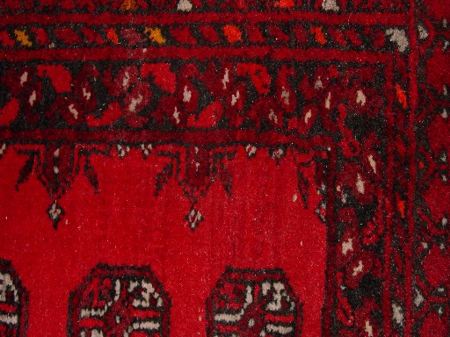
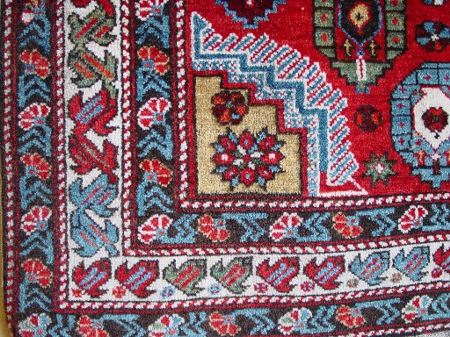
The first is an example of the
Badam/Almond border as used in Afghan Baluch rugs. The second is a Baku/Shirvan.
Interestingly, the "stem" is very short on these two versions compared to the
Anatolian rug above. And looking at the bottom border of the Baku, you can see
what may have been a "single unit" of the border, without stems.
I still
think that these two versions are modified floral meander borders rather than
the possibly more likely "animal-head" border as seen on Luri, Qashqa'i and
Khamseh rugs.
Patrick Weiler
Posted by Tracy Davis on 05-05-2003 04:36 PM:
No fooling
Sorry it took me so long to post the rest of this, Patrick! Here's the
(almost) complete rug:
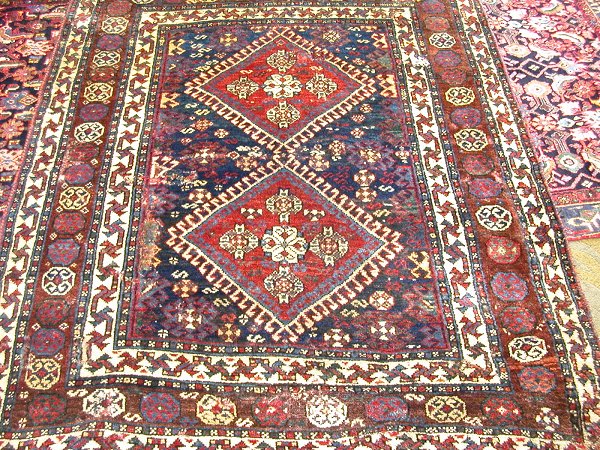
It measures roughly 5'x7', and the structural characteristics
are as follows:
Warp: undyed brown, beige, sometimes ivory 2-ply
wool
Weft: two passes of dull reddish-brown wool, no warp depression (note:
in one place, I saw a third blue cotton weft, extremely thin--almost a thread--
but I never found another.)
Knots: Symmetric, pulled to the right; 6 kpi
horizontal, 8 kpt vertical
Pile: long, almost shaggy
Sides: Red and blue
barber-pole overcasting
Ends: Not extant
I suppose it could certainly
be Khamseh, but there's something about its overall tonality and drawing that
just says Lur to me.
Posted by Chuck Wagner on 05-06-2003 11:08 AM:
Subtle Yet Blatant
Hi Pat,
I don't see the "badam" design connection to the border (who
knows what it's called ?, so I'm going to refer to it as "IT") that we've been
discussing as clearly as you appear to.
"IT" is almost always a very
crude execution, and seems to have been thought of as something to use on a rug
with BIG knots. Most of the images in this thread are of pieces with relatively
coarse weaves, and "IT" fits well with them. However in the rug that Michael
posted, and in the design drawing I posted, the level of detail achievable is
far finer than that of the border. This is a puzzler for me. Why go with a fine
weave and then put a coarse angular border into the design ?
The "badam"
design is generally drawn with well done curves, neat outlines, and no
connecting straight element between the individual "badams". This is true for
Afghan rugs of all ages, and only the coarsest have "badams" with an angular
appearance.
I think "IT" has its origin in either a floral design
element, or (as I mentioned earlier) the boteh design. The design drawing show
the similarity to a boteh; a redundant hook with a flat crossover. There are
several borders in Caucasian and northern Perisan rugs with similar geometries
to "IT", but with floral or leaf terminators on the linear elements. (If I can
scare up a couple images I'll post them).
Here are a few shots of well
done "badams" from Afghan rugs.
The first is a pre-World War II
Sulayman:
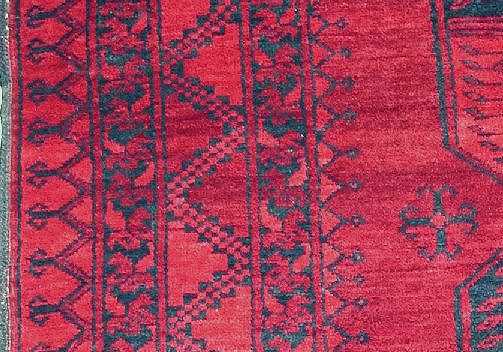
The next
is a 1950's-ish Chob Bash:
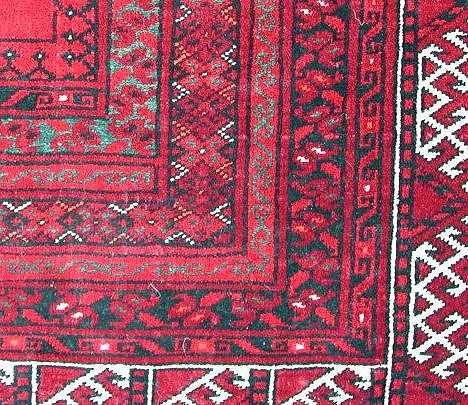
This one is a 1970's-ish piece, probably from Kabul:
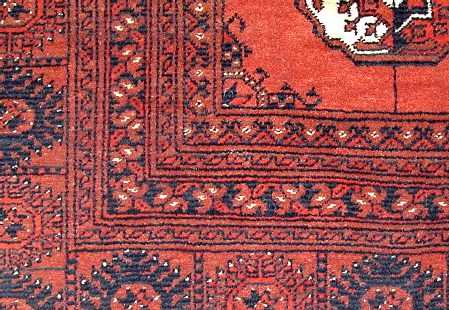
And the last is a recent
piece showing "badams" outside the border arena:
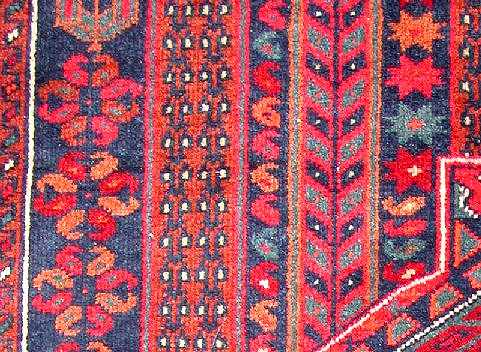
All are used quite differently
from the elements of "IT", which does seem to be pretty consistently represented
in rugs from the cultures along the length of Zagros.
In short I think
they're two different designs.
Regards,
Chuck
__________________
Chuck
Wagner
Posted by Patrick Weiler on 05-06-2003 11:41 PM:
Grand
Tracy,
Your rug is much larger than it appears on my monitor. If it is
5x7 it is nearly as big as the four medallion rug on the salon, so it is not
another "small" Luri like the last rug on the salon. This unusually large size
in relation to the normal smaller format for this design speaks to the Luri
tradition of disproportionate designs.
The dice outer border is seen on the
largest of the salon rugs and, of course, the bird meander border is commonly
used by Luri weavers. The low knot count and light red wefts also point to a
possible Luri source, as do the dark warps.
So, you may actually have a Luri
piece after all. Congratulations for probably downgrading the value  of your estate!
of your estate! 
Patrick Weiler
Posted by Vincent Keers on 05-08-2003 07:56 AM:
From the land of the pillows, some more useless knowledge.
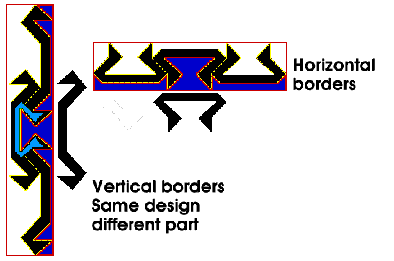
There seems to be a difference
between this design in a horizontal setting and in a vertical setting. In the
Chanteh the border is rotated 90 degrees.
In the Tracy rug a different part,
from the same design is used.
I have two pillows that show this too.
that show this too.
Think in the
coarser pieces we'll find the rotation. In the finer pieces we'll find the more
refined approach? (What am I talking about? Pillows?)
Or does this
have to do with somethig else. Different production? Different
tribe?
Best regards,
Vincent
Posted by Patrick Weiler on 05-09-2003 07:55 PM:
Piece of a puzzle
Vincent,
I see where you point out that Tracy's rug uses just a
section of the larger vertical border design on the horizontal axis.
In the
vertical borders, each "section" is outlined, and the design consists of two
sideways "W" shapes, or sections, nestled neck-to-neck.
The horizontal
design takes one piece from each of three of these "sections" , the top "bird
head" of one section, the middle pole of the section facing the other way, and
the bottom "bird head" of the next section.
This taking apart and recombining
of pieces of a border design to make a different design entirely is similar to
the border in the Baku Shirvan rug where the "tulip" is lopped off the stem and
is set in a row along the horizontal borders:

It is not unusual for this
reconstructin to happen because tribal weavers may have found it difficult to
resolve the corner solution and vertical/horizontal transition of the design.
The question that arises from this conclusion is, which came first, the simpler
horizontal border or the more complex vertical border?
Patrick Weiler
Posted by Patrick Weiler on 05-10-2003 01:06 PM:
Border Patrol
Vincent,
These photos show the small khorjin from the salon. It has
the full animal heads on a pole border on the vertical sides and the modified
version on the horizontal sides.:
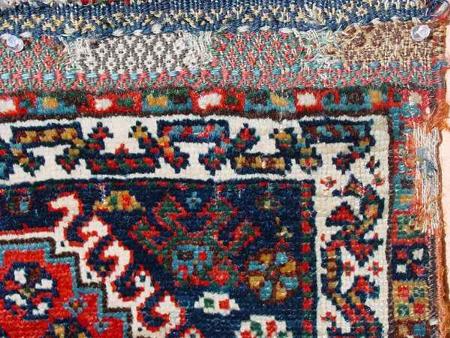
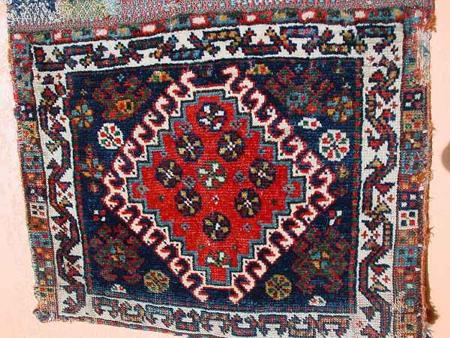
The top border has
changed so much that the bird's heads have disappeared, leaving just a dash and
a slash! -/_\-/_\-/
Patrick Weiler
Posted by Vincent Keers on 05-14-2003 02:33 PM:
Dear Patrick,
Took me some time to digest what it was, I was
thinking.
What you're saying is clear.
The thing is: I'm more and more
obsessed with this
"two bird heads, looking the same direction, on a pole".
pattern.
It can't be found in any other design.
It's a 1 line-symmetry.
The most simple form.
More simple than the S form. That is a rotation
symmetry.
The closest comes Turkman design.
Then I saw the groundplan
from the Rocktempel in
Jerusalem. The groundplan from the Aya Sofia
etc.
In general: How to construct a dome that doesn't come down because of
it's own weight.
Looked at Salon 40 by Mr.Huber.
So I made this
drawing.
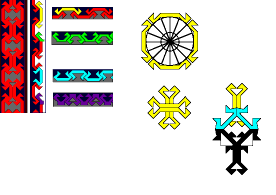
Think
this basic
2 heads-on-a-pole-looking-the-same-direction design
is very
basic.
More basic than
2 heads-on-a-pole-looking-opposite-direction
design
that is a rotation symmetry.
Hmmm......it was fun,
thanks
for the inspiration,
Best regards,
Vincent
PS. Whatever design
you could think of, it can be made with this pattern. Cross, X, etc.
Posted by Patrick Weiler on 05-15-2003 12:48 AM:
Vincent da Vinci
Vincent,
You have performed a masterful deconstruction of this design
element, showing the multitude of permutations possible from a single
source!
Is it possible that the weavers of these works of art also realized
this potential? Or did they naturally gravitate to combinations of this single
element out of necessity?
Your insightful explanation reminds me of what is
known as the Golden Mean, a concept so basic to architectural and artistic
construction that it may be hard-wired into our genetic code. Take a look at
this web site:
http://goldennumber.net/goldsect.htm
Thank you for your
investigation and enlightenment.
Patrick Weiler










 ........
........













 of your estate!
of your estate! 
 that show this too.
that show this too.

